2014 FORD F150 ESP
[x] Cancel search: ESPPage 3 of 41

Introduction
About This Supplement.................................3
Product History..................................................3
At a Glance
At a Glance..........................................................4
Fuel and Refueling
Fuel Quality.........................................................7
Terrain Response
Principle of Operation.....................................8
Using Hill Descent Control............................8
Driving Aids
Front View Camera..........................................9
Towing
Towing a Trailer................................................12
Transporting the Vehicle...............................12
Towing the Vehicle on Four Wheels.........13
Driving Hints
Off-Road Driving.............................................15
Vehicle Care
Cleaning the Exterior.....................................25
Wheels and Tires
General Information......................................26
Tire Care............................................................26
Using Snow Chains........................................27
Wheels................................................................27
Capacities and Specific-ations
Engine Specifications...................................29
Motorcraft Parts.............................................30
Technical Specifications...............................31
Accessories
Auxiliary Switches..........................................33
Warranty Terms andConditions
Base Warranty.................................................35
1F150 (TF6)Table of Contents
Page 5 of 41
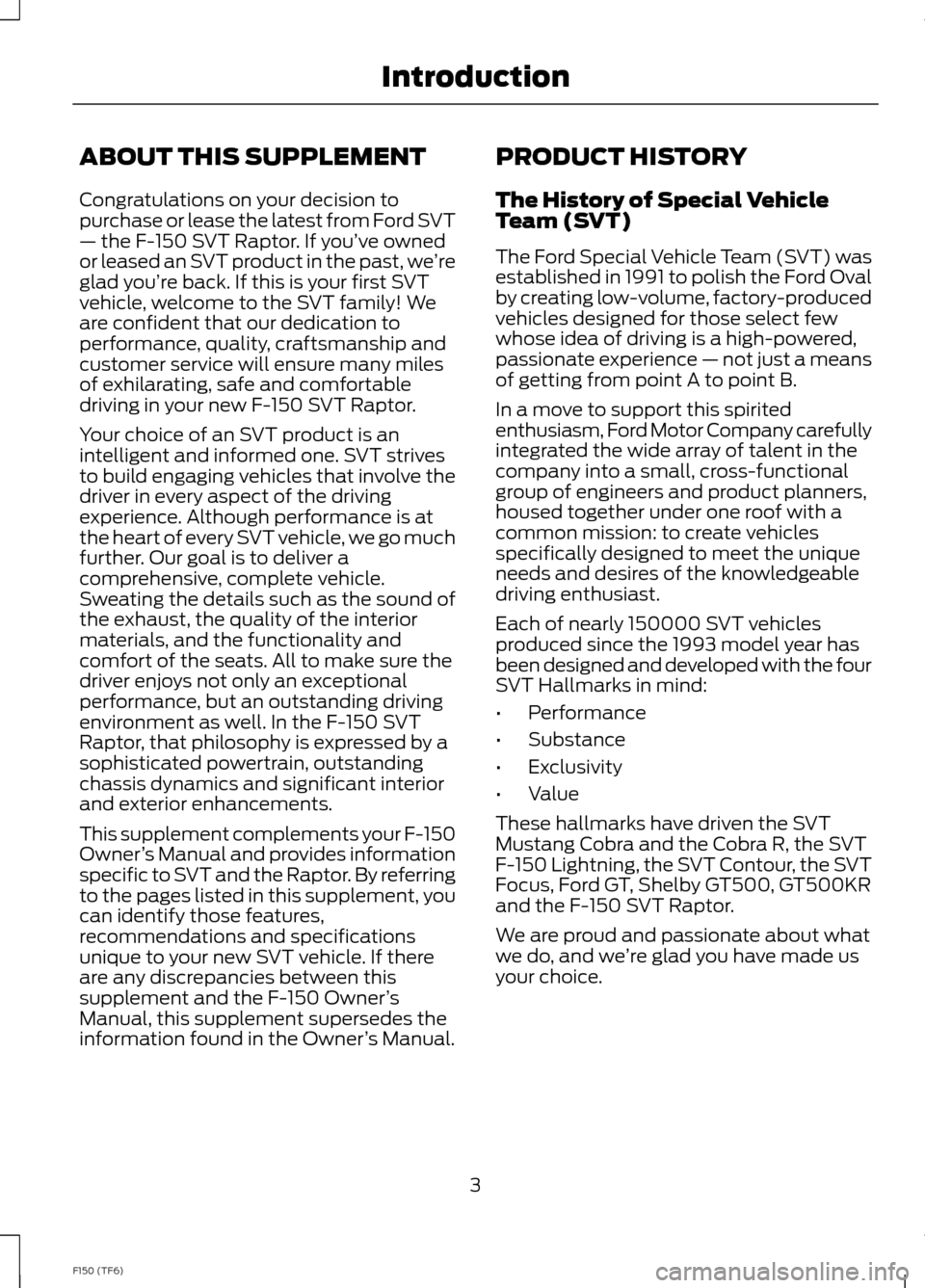
ABOUT THIS SUPPLEMENT
Congratulations on your decision topurchase or lease the latest from Ford SVT— the F-150 SVT Raptor. If you’ve ownedor leased an SVT product in the past, we’reglad you’re back. If this is your first SVTvehicle, welcome to the SVT family! Weare confident that our dedication toperformance, quality, craftsmanship andcustomer service will ensure many milesof exhilarating, safe and comfortabledriving in your new F-150 SVT Raptor.
Your choice of an SVT product is anintelligent and informed one. SVT strivesto build engaging vehicles that involve thedriver in every aspect of the drivingexperience. Although performance is atthe heart of every SVT vehicle, we go muchfurther. Our goal is to deliver acomprehensive, complete vehicle.Sweating the details such as the sound ofthe exhaust, the quality of the interiormaterials, and the functionality andcomfort of the seats. All to make sure thedriver enjoys not only an exceptionalperformance, but an outstanding drivingenvironment as well. In the F-150 SVTRaptor, that philosophy is expressed by asophisticated powertrain, outstandingchassis dynamics and significant interiorand exterior enhancements.
This supplement complements your F-150Owner’s Manual and provides informationspecific to SVT and the Raptor. By referringto the pages listed in this supplement, youcan identify those features,recommendations and specificationsunique to your new SVT vehicle. If thereare any discrepancies between thissupplement and the F-150 Owner’sManual, this supplement supersedes theinformation found in the Owner’s Manual.
PRODUCT HISTORY
The History of Special VehicleTeam (SVT)
The Ford Special Vehicle Team (SVT) wasestablished in 1991 to polish the Ford Ovalby creating low-volume, factory-producedvehicles designed for those select fewwhose idea of driving is a high-powered,passionate experience — not just a meansof getting from point A to point B.
In a move to support this spiritedenthusiasm, Ford Motor Company carefullyintegrated the wide array of talent in thecompany into a small, cross-functionalgroup of engineers and product planners,housed together under one roof with acommon mission: to create vehiclesspecifically designed to meet the uniqueneeds and desires of the knowledgeabledriving enthusiast.
Each of nearly 150000 SVT vehiclesproduced since the 1993 model year hasbeen designed and developed with the fourSVT Hallmarks in mind:
•Performance
•Substance
•Exclusivity
•Value
These hallmarks have driven the SVTMustang Cobra and the Cobra R, the SVTF-150 Lightning, the SVT Contour, the SVTFocus, Ford GT, Shelby GT500, GT500KRand the F-150 SVT Raptor.
We are proud and passionate about whatwe do, and we’re glad you have made usyour choice.
3F150 (TF6)Introduction
Page 10 of 41
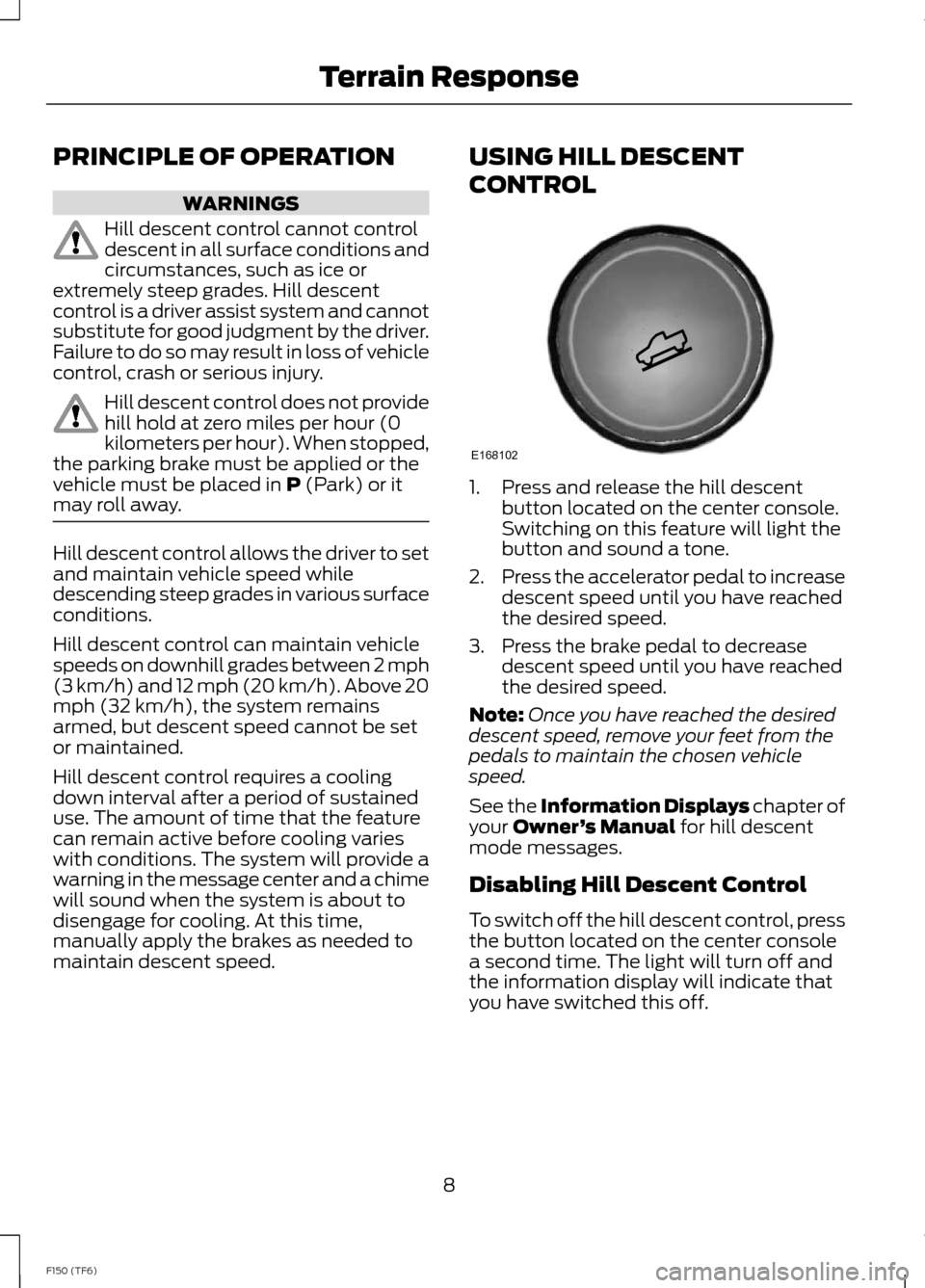
PRINCIPLE OF OPERATION
WARNINGS
Hill descent control cannot controldescent in all surface conditions andcircumstances, such as ice orextremely steep grades. Hill descentcontrol is a driver assist system and cannotsubstitute for good judgment by the driver.Failure to do so may result in loss of vehiclecontrol, crash or serious injury.
Hill descent control does not providehill hold at zero miles per hour (0kilometers per hour). When stopped,the parking brake must be applied or thevehicle must be placed in P (Park) or itmay roll away.
Hill descent control allows the driver to setand maintain vehicle speed whiledescending steep grades in various surfaceconditions.
Hill descent control can maintain vehiclespeeds on downhill grades between 2 mph(3 km/h) and 12 mph (20 km/h). Above 20mph (32 km/h), the system remainsarmed, but descent speed cannot be setor maintained.
Hill descent control requires a coolingdown interval after a period of sustaineduse. The amount of time that the featurecan remain active before cooling varieswith conditions. The system will provide awarning in the message center and a chimewill sound when the system is about todisengage for cooling. At this time,manually apply the brakes as needed tomaintain descent speed.
USING HILL DESCENT
CONTROL
1.Press and release the hill descentbutton located on the center console.Switching on this feature will light thebutton and sound a tone.
2.Press the accelerator pedal to increasedescent speed until you have reachedthe desired speed.
3.Press the brake pedal to decreasedescent speed until you have reachedthe desired speed.
Note:Once you have reached the desireddescent speed, remove your feet from thepedals to maintain the chosen vehiclespeed.
See the Information Displays chapter ofyour Owner’s Manual for hill descentmode messages.
Disabling Hill Descent Control
To switch off the hill descent control, pressthe button located on the center consolea second time. The light will turn off andthe information display will indicate thatyou have switched this off.
8F150 (TF6)Terrain ResponseE168102
Page 17 of 41
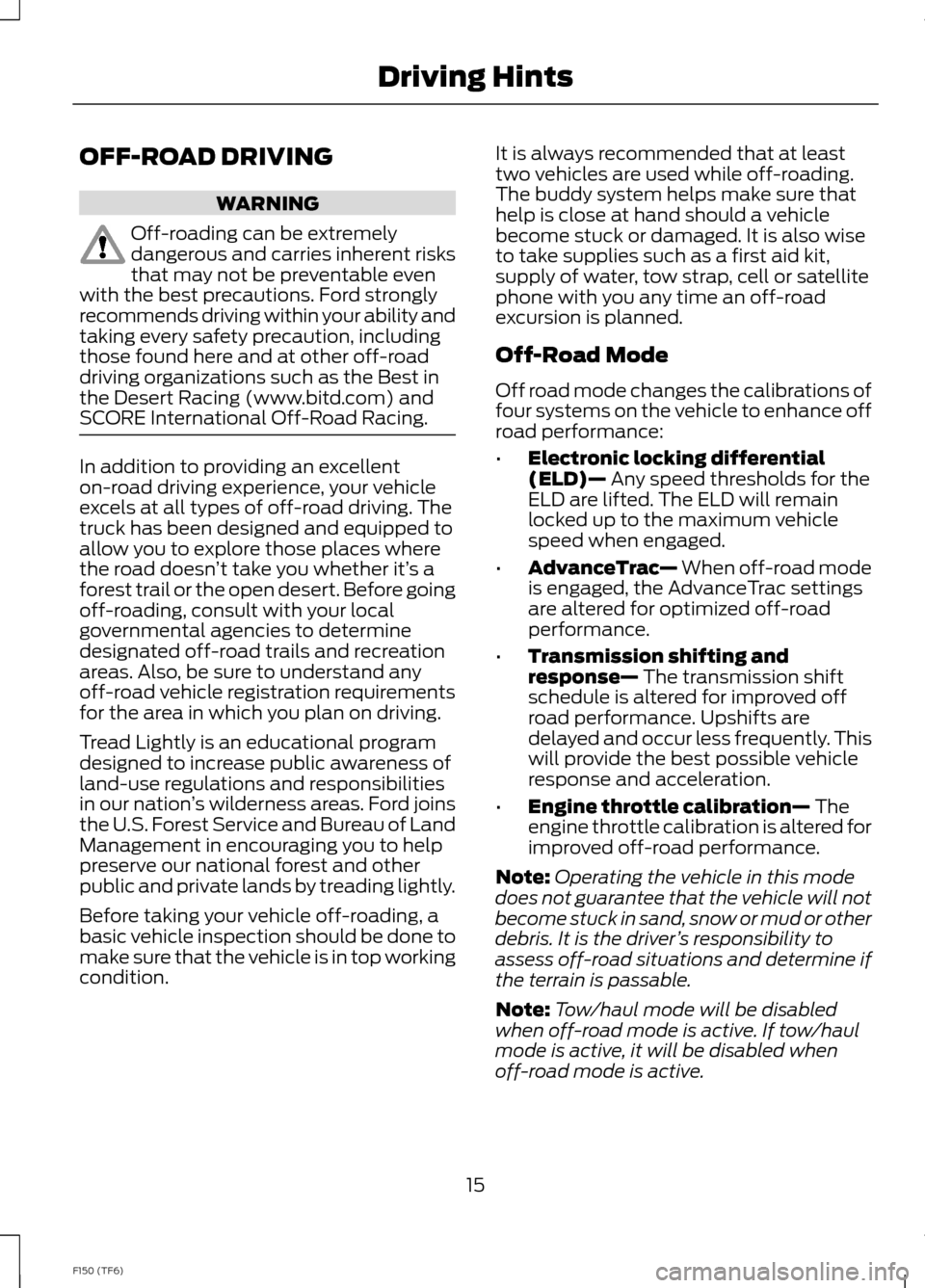
OFF-ROAD DRIVING
WARNING
Off-roading can be extremelydangerous and carries inherent risksthat may not be preventable evenwith the best precautions. Ford stronglyrecommends driving within your ability andtaking every safety precaution, includingthose found here and at other off-roaddriving organizations such as the Best inthe Desert Racing (www.bitd.com) andSCORE International Off-Road Racing.
In addition to providing an excellenton-road driving experience, your vehicleexcels at all types of off-road driving. Thetruck has been designed and equipped toallow you to explore those places wherethe road doesn’t take you whether it’s aforest trail or the open desert. Before goingoff-roading, consult with your localgovernmental agencies to determinedesignated off-road trails and recreationareas. Also, be sure to understand anyoff-road vehicle registration requirementsfor the area in which you plan on driving.
Tread Lightly is an educational programdesigned to increase public awareness ofland-use regulations and responsibilitiesin our nation’s wilderness areas. Ford joinsthe U.S. Forest Service and Bureau of LandManagement in encouraging you to helppreserve our national forest and otherpublic and private lands by treading lightly.
Before taking your vehicle off-roading, abasic vehicle inspection should be done tomake sure that the vehicle is in top workingcondition.
It is always recommended that at leasttwo vehicles are used while off-roading.The buddy system helps make sure thathelp is close at hand should a vehiclebecome stuck or damaged. It is also wiseto take supplies such as a first aid kit,supply of water, tow strap, cell or satellitephone with you any time an off-roadexcursion is planned.
Off-Road Mode
Off road mode changes the calibrations offour systems on the vehicle to enhance offroad performance:
•Electronic locking differential(ELD)— Any speed thresholds for theELD are lifted. The ELD will remainlocked up to the maximum vehiclespeed when engaged.
•AdvanceTrac— When off-road modeis engaged, the AdvanceTrac settingsare altered for optimized off-roadperformance.
•Transmission shifting andresponse— The transmission shiftschedule is altered for improved offroad performance. Upshifts aredelayed and occur less frequently. Thiswill provide the best possible vehicleresponse and acceleration.
•Engine throttle calibration— Theengine throttle calibration is altered forimproved off-road performance.
Note:Operating the vehicle in this modedoes not guarantee that the vehicle will notbecome stuck in sand, snow or mud or otherdebris. It is the driver’s responsibility toassess off-road situations and determine ifthe terrain is passable.
Note:Tow/haul mode will be disabledwhen off-road mode is active. If tow/haulmode is active, it will be disabled whenoff-road mode is active.
15F150 (TF6)Driving Hints
Page 19 of 41
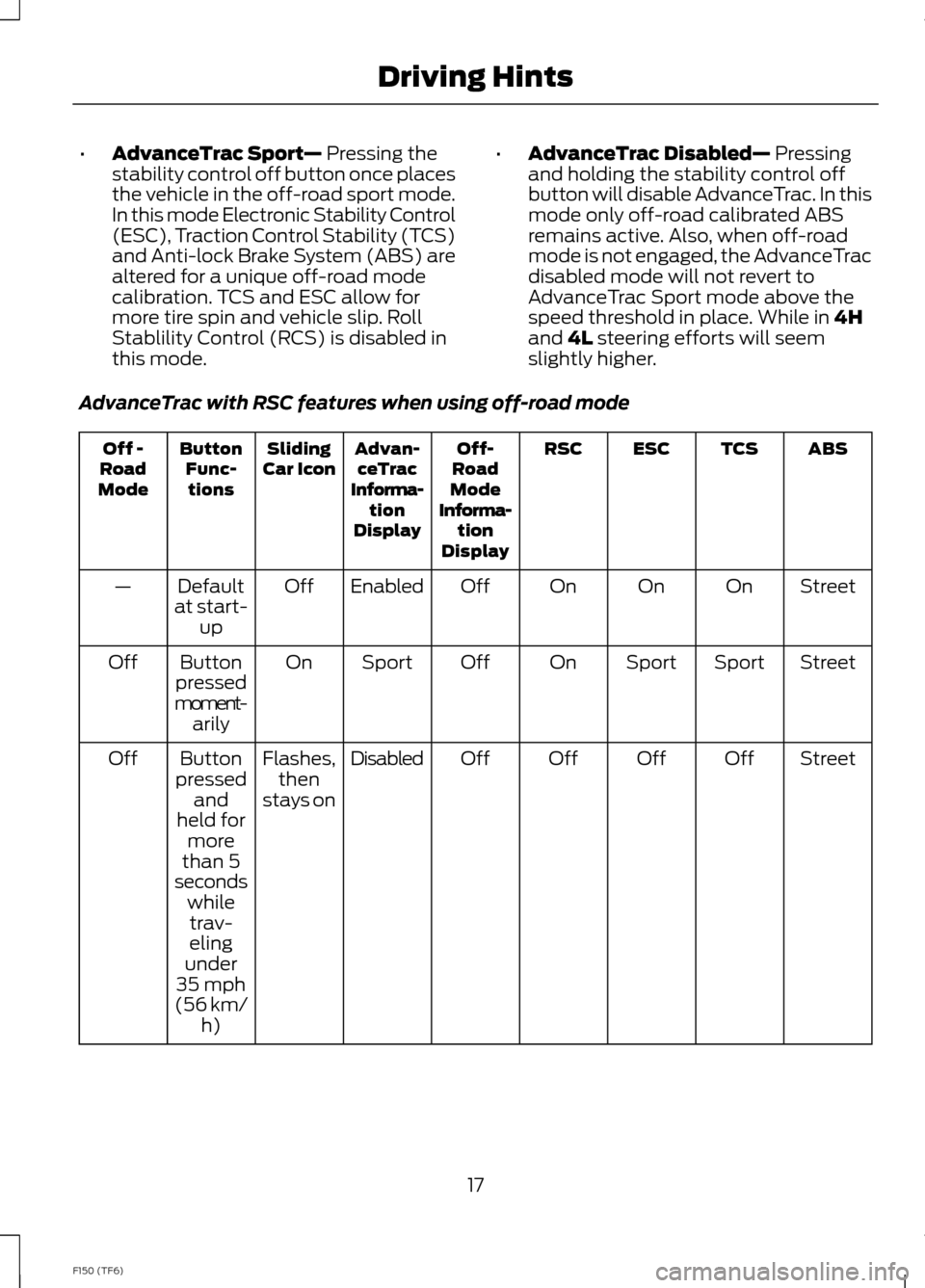
•AdvanceTrac Sport— Pressing thestability control off button once placesthe vehicle in the off-road sport mode.In this mode Electronic Stability Control(ESC), Traction Control Stability (TCS)and Anti-lock Brake System (ABS) arealtered for a unique off-road modecalibration. TCS and ESC allow formore tire spin and vehicle slip. RollStablility Control (RCS) is disabled inthis mode.
•AdvanceTrac Disabled— Pressingand holding the stability control offbutton will disable AdvanceTrac. In thismode only off-road calibrated ABSremains active. Also, when off-roadmode is not engaged, the AdvanceTracdisabled mode will not revert toAdvanceTrac Sport mode above thespeed threshold in place. While in 4Hand 4L steering efforts will seemslightly higher.
AdvanceTrac with RSC features when using off-road mode
ABSTCSESCRSCOff-RoadModeInforma-tionDisplay
Advan-ceTracInforma-tionDisplay
SlidingCar IconButtonFunc-tions
Off -RoadMode
StreetOnOnOnOffEnabledOffDefaultat start-up
—
StreetSportSportOnOffSportOnButtonpressedmoment-arily
Off
StreetOffOffOffOffDisabledFlashes,thenstays on
Buttonpressedandheld formorethan 5
Off
secondswhiletrav-elingunder35 mph(56 km/h)
17F150 (TF6)Driving Hints
Page 20 of 41
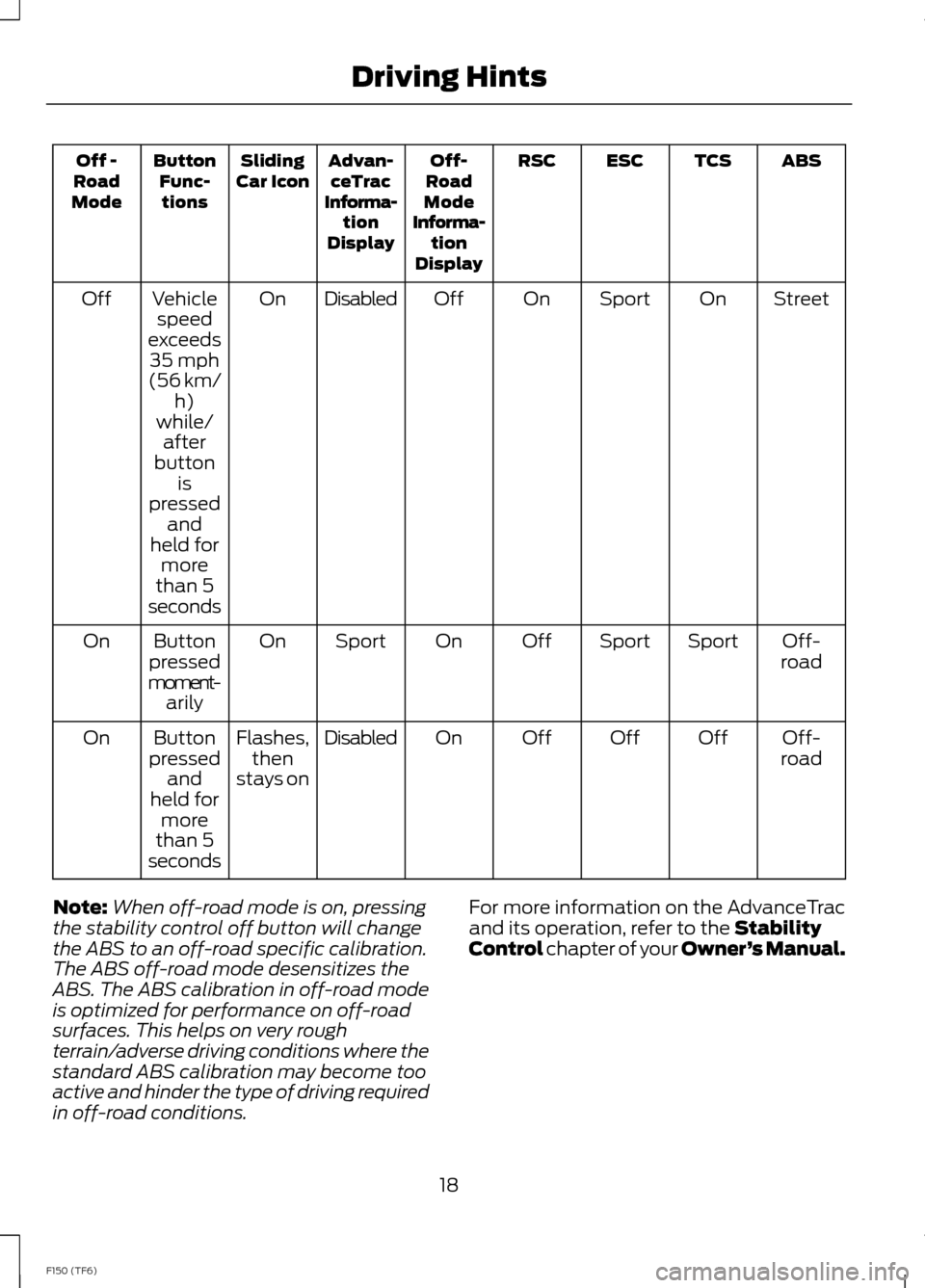
ABSTCSESCRSCOff-RoadModeInforma-tionDisplay
Advan-ceTracInforma-tionDisplay
SlidingCar IconButtonFunc-tions
Off -RoadMode
StreetOnSportOnOffDisabledOnVehiclespeedexceeds35 mph(56 km/h)
Off
while/afterbuttonispressedandheld formorethan 5seconds
Off-roadSportSportOffOnSportOnButtonpressedmoment-arily
On
Off-roadOffOffOffOnDisabledFlashes,thenstays on
Buttonpressedandheld formorethan 5seconds
On
Note:When off-road mode is on, pressingthe stability control off button will changethe ABS to an off-road specific calibration.The ABS off-road mode desensitizes theABS. The ABS calibration in off-road modeis optimized for performance on off-roadsurfaces. This helps on very roughterrain/adverse driving conditions where thestandard ABS calibration may become tooactive and hinder the type of driving requiredin off-road conditions.
For more information on the AdvanceTracand its operation, refer to the StabilityControl chapter of your Owner’s Manual.
18F150 (TF6)Driving Hints
Page 21 of 41

Off-road Screen
The real-time status of your vehiclesoff-road systems can be continuouslymonitored using the first off-road screenfound under the Truck Apps menu in theinformation displays screen. See theInformation Displays chapter of yourOwner’s Manual for more information.
Basic Off-road Driving Techniques
•
•Grip the steering wheel with thumbson the outside of the rim. This willreduce the risk of injury due to abruptsteering wheel motions that occurwhen negotiating rough terrain. Do notgrip the steering wheel with thumbsinside the rim.
•Throttle, brake and steering inputsshould be made in a smooth andcontrolled manner. Sudden inputs tothe controls can cause loss of tractionor upset the vehicle, especially whileon sloped terrain or while crossingobstacles such as rocks or logs.
•Look ahead on your route notingupcoming obstacles, surface textureor color changes or any other factorswhich may indicate a change inavailable traction, and adjust thevehicle speed and route accordingly.During pre-run, mark obstacles withGPS markers to make sure appropriatespeeds are used to avoid potentialvehicle damage.
•When driving off-road, if the front orrear suspension is bottoming-outand/or excessive contact with theskid-plates is encountered, reducevehicle speed to avoid potentialdamage to the vehicle.
•When running with other vehicles, it isrecommended that communication isused, and the lead vehicle notify othervehicles of obstacles that could causepotential vehicle damage.
•Always keep available groundclearance in mind and pick a route thatminimizes the risk of catching theunderside of the vehicle on an obstacle.
•When negotiating low speed obstacles,applying light brake pressure inconjunction with the throttle will helpprevent the vehicle from jerking andwill allow you to negotiate the obstaclein a more controlled manner. Using 4Lwill also help with this.
•Use and equip supplemental safetyequipment as discussed later in thischapter.
•Please consult your local off-roadgroup for other helpful tips.
•Off-roading requires a high degree ofconcentration. Even if your local lawdoes not prohibit alcohol use whiledriving off-road, Ford stronglyrecommends against drinking if youplan to off-road.
Operating a Performance Vehicleat Higher than Normal Speeds
Your vehicle is capable of operating athigher than normal off-road speeds and isequipped with tires rated for the vehicles’maximum speed. However, it is importantto remember to always drive safely, obeyall traffic laws and only operate yourvehicle at higher than normal speeds atlocations and under conditions where suchcan be done safely.
19F150 (TF6)Driving Hints
Page 22 of 41
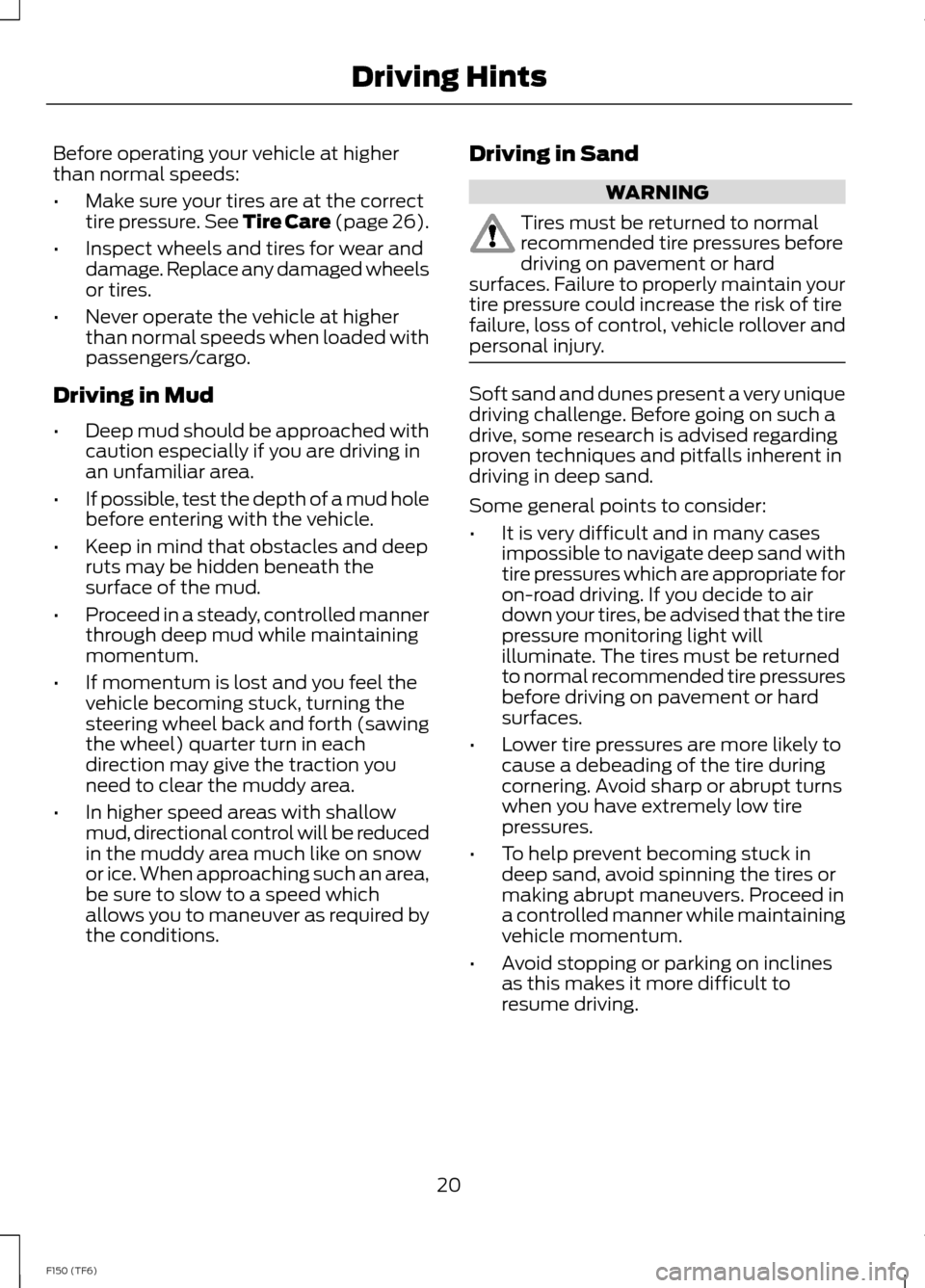
Before operating your vehicle at higherthan normal speeds:
•Make sure your tires are at the correcttire pressure. See Tire Care (page 26).
•Inspect wheels and tires for wear anddamage. Replace any damaged wheelsor tires.
•Never operate the vehicle at higherthan normal speeds when loaded withpassengers/cargo.
Driving in Mud
•Deep mud should be approached withcaution especially if you are driving inan unfamiliar area.
•If possible, test the depth of a mud holebefore entering with the vehicle.
•Keep in mind that obstacles and deepruts may be hidden beneath thesurface of the mud.
•Proceed in a steady, controlled mannerthrough deep mud while maintainingmomentum.
•If momentum is lost and you feel thevehicle becoming stuck, turning thesteering wheel back and forth (sawingthe wheel) quarter turn in eachdirection may give the traction youneed to clear the muddy area.
•In higher speed areas with shallowmud, directional control will be reducedin the muddy area much like on snowor ice. When approaching such an area,be sure to slow to a speed whichallows you to maneuver as required bythe conditions.
Driving in Sand
WARNING
Tires must be returned to normalrecommended tire pressures beforedriving on pavement or hardsurfaces. Failure to properly maintain yourtire pressure could increase the risk of tirefailure, loss of control, vehicle rollover andpersonal injury.
Soft sand and dunes present a very uniquedriving challenge. Before going on such adrive, some research is advised regardingproven techniques and pitfalls inherent indriving in deep sand.
Some general points to consider:
•It is very difficult and in many casesimpossible to navigate deep sand withtire pressures which are appropriate foron-road driving. If you decide to airdown your tires, be advised that the tirepressure monitoring light willilluminate. The tires must be returnedto normal recommended tire pressuresbefore driving on pavement or hardsurfaces.
•Lower tire pressures are more likely tocause a debeading of the tire duringcornering. Avoid sharp or abrupt turnswhen you have extremely low tirepressures.
•To help prevent becoming stuck indeep sand, avoid spinning the tires ormaking abrupt maneuvers. Proceed ina controlled manner while maintainingvehicle momentum.
•Avoid stopping or parking on inclinesas this makes it more difficult toresume driving.
20F150 (TF6)Driving Hints